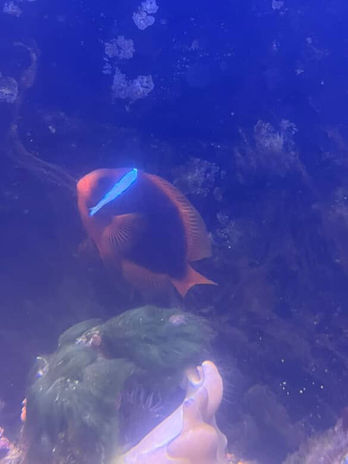Tomato Clownfish
(Amphiprion Frenatus)
Conservation Status: Least concern
The tomato clownfish is a member of the pomacentridae family, which includes clownfish and damselfish. The tomato clownfish does not have a similar appearance to the classic ocellaris clownfish that most people think of when you hear the name clownfish. This species is named for its bright red or burnt orange coloring. Unlike classic clownfish, the juvenile tomato is born with two white stripes, but as they grow they lose one, leaving only one white stripe behind the eye. Tomato clownfish are one of the larger species, and can grow up to 14cm. Typically the females are larger than males. Tomato clownfish can sometimes be confused with cinnamon clownfish, but some distinguishing factors are that the cinnamon clownfish has a wider head band and black anal and pelvic fins. Tomato clownfish are native to the western pacific seas, specifically the lagoon reefs of the South China Sea, Borneo, Sumatra, Philippines, Taiwan, Thailand, Vietnam, and southern Japan.
The tomato clownfish is omnivorous, meaning it eats both plants and animals. In the wild they can be found feeding primarily on zooplankton, small crustaceans, and algae. Their captive diet is slightly different, in aquariums like ours they are fed a diet of brine, mysis, krill, and shrimp.
Because they can grow to a large size, tomato clownfish can become a dominant species in small aquariums. They will strongly defend their territory, but they also remain peaceful and coexist with other species of fish who are not among the clownfish family. They are selective with their host anemones, and like most clownfish are most commonly connected to bubble tip anemones. The tomato clownfish does not need a host anemone to survive, but they are very welcoming of the relationship. In the wild tomato clownfish commonly live to be between 6 and 10 years old. With the care of humans in captivity they can live to be up to 18 years old.
Fun Facts:
Most clownfish are born male, and the dominant male will turn female
Older tomato clownfish may turn black
They have a symbiotic relationship with anemones, they provide food and clean the anemone, and in turn it provides protection.
Males perform courtship rituals by chasing the female and erecting his fins.
%20(1).jpg)

